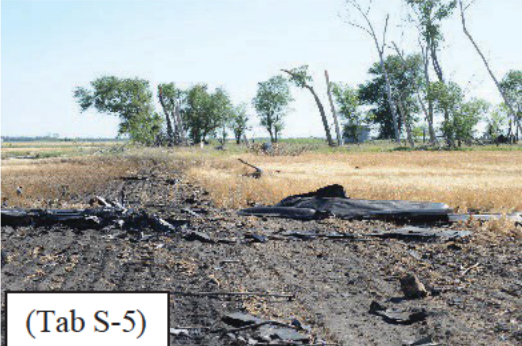A drone pilot and an instructor at Grand Forks Air Force Base, N.D., failed to realize an RQ-4 was 4,000 feet too high as it started its final approach and didn’t select the proper commands, leading the unmanned aerial system to overshoot the base and crash nearly seven miles away, according to a new accident investigation board report.
The Aug. 6, 2021 crash of the RQ-4 was also caused by an initial workstation lockup and a failure by another pilot with the mission control element to promptly sever its control link to the RQ-4, the report found.
The RQ-4, valued at $64 million when it was purchased in 2012, was destroyed when it crashed into a rural field. There were no injuries related to the crash.
In a 38-page report, the accident investigation board detailed a series of mishaps that led to the eventual crash and loss of the aircraft, which was flown by the 348th Reconnaissance Squadron of the 319th Reconnaissance Wing.
The drone took off Aug. 5, scheduled to participate first in a Red Flag exercise and then in a target location error mission. It had been in the air nearly 14 hours when the mission control element’s workstations locked up, causing the RQ-4 to proceed back to base on a preprogrammed, autonomous route.
The mission control element pilot, however, failed to follow established procedure and promptly sever communication and control between the ground control station and the airframe, which would have caused the drone to land autonomously, again using a preprogrammed route. Instead, the pilot didn’t sever the connection until after the drone had passed its final approach fix, triggering a go-around/missed approach route.
Shortly after that, a second pilot and an instructor took command of the drone via the launch and recovery element and instituted an altitude override command instead of commanding a new flight route. As a result, the RQ-4 continued on its go-around/missed approach route while flying 4,000 feet higher than it should have according to its preprogrammed route, and neither the instructor nor the pilot recognized this.
Unable to descend fast enough to account for that 4,000-foot discrepancy, the drone overshot the base and crashed.
The AIB report stated that the main cause of the crash was the second pilot’s incorrect selection of aircraft flight commands and the instructor’s “failure to provide sufficient inputs to the pilot.”
The report also faulted the first pilot for not following procedures, which caused a delayed descent and triggered the go-around/missed approach route, and the station lockup—the report did not definitively identify the cause of the lockup, but noted that the first pilot was recorded as having requested several detailed status reports in the span of one minute, and “the log time for the workstation lockup does coincide with the time for the status requests.”
The RQ-4 that was destroyed was a Block 40 variant, one of just 10 in the Air Force fleet, all of which are stationed at Grand Forks.
